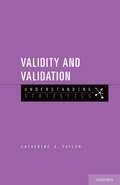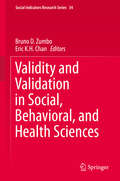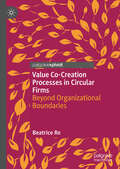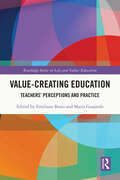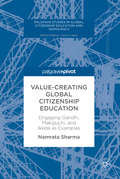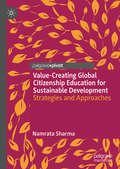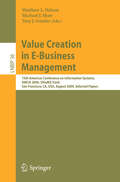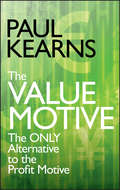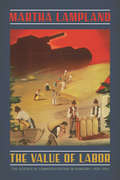- Table View
- List View
The Vagabond in the South Asian Imagination: Resilience, Agency and Representation
by Avishek RayThis book discusses the epistemic foundation of the heuristic construct ‘vagabond’ and the convergence between the politics of itinerancy and that of dissent in the context of South Asia. It describes the fraught relationship between ‘native’ itinerant practices and techniques of governmentality which have furnished different categorizations and taxonomies of mobility. The book demonstrates the historical seismic breaks – from the Orientalist to the post-Orientalist, from the premodern to the modern, and from the colonial to the post-colonial – in the representation of the vagabond in the juridico-political imagination, in historiography and cultural articulation. For instance, the drunk European sailor, the quasi-religious mendicant, and the helpless famine refugee have all been referred to as ‘vagabonds’ in the colonial archive. This book examines the histories and conditions behind these conceptual overlaps, as well as the uncanny associations among categories that uneasily coexist and mirror each other as subsets of a vast range of phenomena, which may loosely be called ‘vagabond(age)’. This volume will be of interest to students and researchers of literature, cultural studies, colonial and post-colonial studies, history, migration studies, sociology, and South Asia studies.
Validating a Best Practice: A Tool for Improvement and Benchmarking
by Yves Van Nuland Grace L. DuffySharing Best Practices across industries and functions is an accepted approach to continuous improvement. The Benchmarking trend of the 1990s has evolved with the help of competitive analysis, performance excellence awards, and other corporate recognition programs into an ongoing documentation of what works. Bob Camp introduced benchmarking against a Best Practice based on his work at Xerox in the 1980s. Case studies abound documenting Best Practice functions and processes. Some case studies use the words “Best Practice” without evidence that the process, results, or methods are, indeed, superior. What is missing is a comprehensive model for assessing and writing a Best Practice that provides sufficient information to use as an effective benchmark. This book provides that comprehensive model. Today’s consumers expect products and services to be of high quality, reliable, and user-friendly. This is the result of years of continuous improvement and innovation by producers. Although many organizations strive for excellent results, there is still room for improvement. Unfortunately, leaders don’t always have methods and tools to measure or assess that degree of excellence. If leaders could use a tool to discover how good their approaches and methods are, and how excellent their achieved results are, they could plan further improvements. The goal is to achieve excellent results. The tool described in this book guides leaders to achieve that excellence.
Validating a Best Practice: A Tool for Improvement and Benchmarking
by Yves Van Nuland Grace L. DuffySharing Best Practices across industries and functions is an accepted approach to continuous improvement. The Benchmarking trend of the 1990s has evolved with the help of competitive analysis, performance excellence awards, and other corporate recognition programs into an ongoing documentation of what works. Bob Camp introduced benchmarking against a Best Practice based on his work at Xerox in the 1980s. Case studies abound documenting Best Practice functions and processes. Some case studies use the words “Best Practice” without evidence that the process, results, or methods are, indeed, superior. What is missing is a comprehensive model for assessing and writing a Best Practice that provides sufficient information to use as an effective benchmark. This book provides that comprehensive model. Today’s consumers expect products and services to be of high quality, reliable, and user-friendly. This is the result of years of continuous improvement and innovation by producers. Although many organizations strive for excellent results, there is still room for improvement. Unfortunately, leaders don’t always have methods and tools to measure or assess that degree of excellence. If leaders could use a tool to discover how good their approaches and methods are, and how excellent their achieved results are, they could plan further improvements. The goal is to achieve excellent results. The tool described in this book guides leaders to achieve that excellence.
Validity and Validation (Understanding Statistics)
by Catherine S. TaylorThe Understanding Research series focuses on the process of writing up social research. The series is broken down into three categories: Understanding Statistics, Understanding Measurement, and Understanding Qualitative Research. The books provide researchers with guides to understanding, writing, and evaluating social research. Each volume demonstrates how research should be represented, including how to write up the methodology as well as the research findings. Each volume also reviews how to appropriately evaluate published research. Validity and Validation is an introduction to validity theory and to the methods used to obtain evidence for the validity of research and assessment results. The book pulls together the best thinking from educational and psychological research and assessment over the past 50 years. It briefly describes validity theory's roots in the philosophy of science. It highlights the ways these philosophical perspectives influence concepts of internal and external validity in research methodology, as well as concepts of validity and reliability in educational and psychological tests and measurements. Each chapter provides multiple examples (e.g., research designs and examples of output) to help the readers see how validation work is done in practice, from the ways we design research studies to the ways we interpret research results. Of particular importance is the practical focus on validation of scores from tests and other measures. The book also addresses strategies for investigating the validity of inferences we make about examinees using scores from assessments, as well as how to investigate score uses, the value implications of score interpretations, and the social consequences of score use. With this foundation, the book presents strategies for minimizing threats for validity as well as quantitative and qualitative methods for gathering evidence for the validity of scores.
Validity and Validation in Social, Behavioral, and Health Sciences (Social Indicators Research Series #54)
by Bruno D. Zumbo Eric K.H. ChanThis book combines an overview of validity theory, trends in validation practices and a review of standards and guidelines in several international jurisdictions with research synthesis of the validity evidence in different research areas. An overview of theory is both useful and timely, in view of the increased use of tests and measures for decision-making, ranking and policy purposes in large-scale testing, assessment and social indicators and quality of life research. Research synthesis is needed to help us assemble, critically appraise and integrate the overwhelming volume of research on validity in different contexts. Rather than examining whether any given measure is “valid”, the focus is on a critical appraisal of the kinds of validity evidence reported in the published research literature. The five sources of validity evidence discussed are: content-related, response processes, internal structure, associations with other variables and consequences. The 15 syntheses included here, represent a broad sampling of psychosocial, health, medical and educational research settings, giving us an extensive evidential basis to build upon earlier studies. The book concludes with a meta-synthesis of the 15 syntheses and a discussion of the current thinking of validation practices by leading experts in the field.
Value and Virtue in Public Administration: A Comparative Perspective (Governance and Public Management)
by Michiel S. De Vries and Pan Suk KimA multidisciplinary analysis of the role of values and virtue in public administration, this book calls for a rediscovery of virtue. It explores ways of enabling the public sector to balance the values that are presently dominant with classic values such as accountability, representation, equality, neutrality, transparency and the public interest.
Value Base of Social Work and Social Care (UK Higher Education OUP Humanities & Social Sciences Health & Social Welfare)
by Adam Barnard Nigel Horner Jim WildFeaturing contributions from key commentators including Lena Dominelli, Sarah Banks, Peter Beresford, Michael Flood and George Ritzer, this diverse text explores an array of concepts and themes that are vital to our understanding of the value base in social work. Each chapter contains a range of exercises and activities that are intended to encourage students to take a creative and active learning approach to defining and understanding values. Among the key themes examined in the book are the tensions between values such as social justice, anti-oppressive practice, compassion, empathy and the contemporary preoccupation with cost codes, performance management, the obsessive cult of managerialism and the allure from those with power in public life for the emerging 'free market'.Also included are chapters on:anti-oppressive practiceservice user valuesanti-social careviolence preventionvaluing equality The Value Base of Social Work and Social Care is a key text for students undertaking the qualifying social work degree, and for those studying youth work, youth justice, education welfare, probation, health care, counselling and community work. Due to the range of contributors and the current emphasis placed on interprofessional working, it is also relevant to an international audience of practitioners and professionals within the field of social care.
Value Co-Creation Processes in Circular Firms: Beyond Organizational Boundaries
by Beatrice ReThis book investigates value co-creation processes within the context of circular entrepreneurship. By rooting the book in value co-creation theory, the author addresses the following research questions: How do value co-creation processes impact organizations? And how could circular firms gain legitimacy through value co-creation processes? Through an empirical study based on interviews with circular entrepreneurs and focus groups involving both entrepreneurs and a sample of co-creating customers, the author offers an empirical framework of value co-creation processes and resulting organizational changes. The book is informative for both academics and practitioners. From a theoretical point of view, it contributes to value co-creation theory, the growing circular entrepreneurship literature, and organizational studies. From a managerial perspective, it informs aspiring circular entrepreneurs and managers about the potential of value co-creation processes in supporting their firms in gaining legitimacy and becoming learning organizations.
Value-Creating Education: Teachers’ Perceptions and Practice (Routledge Series on Life and Values Education)
by Emiliano Bosio Maria GuajardoOffering a pivotal reference point and a wide range of global perspectives of teaching experiences on value-creating education (VCE), this book is a timely spotlight on contemporary issues of globalisation that many educational institutions around the world may encounter. It contributes to the originality of constructing new knowledge in the field of VCE, a forward-looking framework, and an ethical and educational imperative that can be understood in different ways, from diverse theoretical orientations. The chapters written by experienced international educators explore the following questions: How do educators understand the role of VCE? What pedagogical approaches to VCE do educators employ in their classes? How do educators support the values and knowledge of VCE in all curricular areas? What do educators see as the key essential values and knowledge that students should develop through VCE? It offers valuable insights and applied pedagogical practices for postgraduate students, researchers, educational policy makers, curriculum developers, and decision-makers in higher education institutions and non-governmental organizations (e.g., UNESCO, OXFAM).
Value-Creating Education: Teachers’ Perceptions and Practice (Routledge Series on Life and Values Education)
by Emiliano Bosio Maria GuajardoOffering a pivotal reference point and a wide range of global perspectives of teaching experiences on value-creating education (VCE), this book is a timely spotlight on contemporary issues of globalisation that many educational institutions around the world may encounter. It contributes to the originality of constructing new knowledge in the field of VCE, a forward-looking framework, and an ethical and educational imperative that can be understood in different ways, from diverse theoretical orientations. The chapters written by experienced international educators explore the following questions: How do educators understand the role of VCE? What pedagogical approaches to VCE do educators employ in their classes? How do educators support the values and knowledge of VCE in all curricular areas? What do educators see as the key essential values and knowledge that students should develop through VCE? It offers valuable insights and applied pedagogical practices for postgraduate students, researchers, educational policy makers, curriculum developers, and decision-makers in higher education institutions and non-governmental organizations (e.g., UNESCO, OXFAM).
Value-Creating Global Citizenship Education: Engaging Gandhi, Makiguchi, and Ikeda as Examples (Palgrave Studies in Global Citizenship Education and Democracy)
by Namrata SharmaThis book fills an existing gap within the practice of global citizenship education by offering Asian perspectives. In this book, Soka or value-creating education developed by the Japanese educators, Tsunesaburo Makiguchi (1871-1944) and Daisaku Ikeda (b. 1928) is compared to the ideas of the Indian political leader Mahatma Gandhi (1869-1948). This study of their respective thoughts and movements has a significant bearing on the three domains of learning within the global citizenship education conceptual dimensions of UNESCO – the cognitive, socio-emotional, and behavioral. This book deftly combines theoretical discussions with themes and suggestions for practice and future research.
Value-Creating Global Citizenship Education: Engaging Gandhi, Makiguchi, and Ikeda as Examples (Palgrave Studies in Global Citizenship Education and Democracy)
by Namrata SharmaThis book fills an existing gap within the practice of global citizenship education by offering Asian perspectives. In this book, Soka or value-creating education developed by the Japanese educators, Tsunesaburo Makiguchi (1871-1944) and Daisaku Ikeda (b. 1928) is compared to the ideas of the Indian political leader Mahatma Gandhi (1869-1948). This study of their respective thoughts and movements has a significant bearing on the three domains of learning within the global citizenship education conceptual dimensions of UNESCO – the cognitive, socio-emotional, and behavioral. This book deftly combines theoretical discussions with themes and suggestions for practice and future research.
Value-Creating Global Citizenship Education for Sustainable Development: Strategies and Approaches (Palgrave Studies in Global Citizenship Education and Democracy)
by Namrata SharmaThis volume brings together marginalized perspectives and communities into the mainstream discourse on education for sustainable development and global citizenship. Building on her earlier work, Sharma uses non-western perspectives to challenge dominant agendas and the underlying Western worldview in the UNESCO led discourse on global citizenship education. Chapters develop the theoretical framework around the three domains of learning within the global citizenship education conceptual dimensions of UNESCO--the cognitive, socio-emotional, and behavioral--and offer practical insights for educators. Value-creating global citizenship education is offered as a pedagogical approach to education for sustainable development and global citizenship in addition to and complementing other approaches mentioned within the recent UNESCO guidelines.
Value Creation in E-Business Management: 15th Americas Conference on Information Systems, AMCIS 2009, SIGeBIZ track, San Francisco, CA, USA, August 6-9, 2009, Selected Papers (Lecture Notes in Business Information Processing #36)
by Matthew L. Nelson Michael J. Shaw Troy J. StraderRecent economic, political, and technological forces are changing the landscape of electronic business and electronic commerce. Although great strides have been made over the past in understanding, researching and advancing e-business, rarely have we witnessed its use so profound and yet its limitations so pronounced, than what has been on global public display for the past 18 months. As a result, new e-commerce strategies and techniques are emerging, collaborative value creation is essential and e-business models are being refined and developed, with special attention towards IS in financial markets, health care and related institutions. It is for these reasons (and many more) that we are so particularly excited and grateful for the collection of papers included in this Value Creation in e-Business Management LNBIP volume number 36. The papers selected in this volume address these emerging e-business issues and are organized into four research lines: Business Models for the Digital Economy, Electronic and Mobile Commerce Behavioral and Global Issues, IS in Financial M- kets and Institutions, Web 2. 0 and E-Commerce and Collaborative Value Creation. The first group, Business Models for the Digital Economy, provides a closer exami- tion of business models from a rich mixture of segments in the IT industry. They - clude Hoyer and Stanoevska-Slabeva’s business model types for enterprise mashup intermediaries, Riehle’s ‘commercial’ open source business model, Chen’s interesting comparison between i-Phone versus Kindles in electronic book sales, and Lyons and coauthors business models in emerging online services.
Value Creation through Executive Development
by Solomon AkrofiThe ability of organisations to generate long-term value and growth depends to a very large extent on the capacity of the executive cohort to conceive and implement strategic initiatives through a well-motivated and enabled workforce. However, generating consistent value in today’s volatile, uncertain, complex and ambiguous (VUCA) and rapidly evolving digital economic landscape can be challenging and, therefore, executives need to update their capabilities regularly to align with the changing value drivers required for long-term growth. To achieve the expected value and growth at a more sustainable level, executive development must be managed as a strategic asset and optimised through effective design and implementation and the effects must be proactively evaluated through meaningful leading indicators and actual 'hard' measures. Value Creation through Executive Development, therefore, offers a well-supported and clearly structured approach to address the gap between executive development initiatives and the creation of long-term organisational value and growth. This book provides a valuable resource to executives and management development professionals who have experienced frustration about the lack of non-value-adding executive development programmes. It also serves as a professional resource for managers of executive and management development programmes, organisational development departments and organisational development consultants, allowing them to integrate this material into existing programmes to achieve value-centric outcomes and to achieve long-term performance targets. Additionally, it serves as a teaching resource for participants in executive/management development courses or seminars globally; offering them the capacity to conduct value-centric initiatives and gain the capacity to influence the tactical, operational and strategic dimensions of their organisational performance.
Value Creation through Executive Development
by Solomon AkrofiThe ability of organisations to generate long-term value and growth depends to a very large extent on the capacity of the executive cohort to conceive and implement strategic initiatives through a well-motivated and enabled workforce. However, generating consistent value in today’s volatile, uncertain, complex and ambiguous (VUCA) and rapidly evolving digital economic landscape can be challenging and, therefore, executives need to update their capabilities regularly to align with the changing value drivers required for long-term growth. To achieve the expected value and growth at a more sustainable level, executive development must be managed as a strategic asset and optimised through effective design and implementation and the effects must be proactively evaluated through meaningful leading indicators and actual 'hard' measures. Value Creation through Executive Development, therefore, offers a well-supported and clearly structured approach to address the gap between executive development initiatives and the creation of long-term organisational value and growth. This book provides a valuable resource to executives and management development professionals who have experienced frustration about the lack of non-value-adding executive development programmes. It also serves as a professional resource for managers of executive and management development programmes, organisational development departments and organisational development consultants, allowing them to integrate this material into existing programmes to achieve value-centric outcomes and to achieve long-term performance targets. Additionally, it serves as a teaching resource for participants in executive/management development courses or seminars globally; offering them the capacity to conduct value-centric initiatives and gain the capacity to influence the tactical, operational and strategic dimensions of their organisational performance.
Value Dominant Logic: Helping Individuals and Their Companies to Succeed
by Gautam MahajanIncreasing disruption, diminishing returns, and demanding customers require business leaders to create more value, remain relevant, and stay ahead of competition. CEOs must evolve a "value creation" culture for the company in order to properly balance the interests of customers, employees, investors, and the marketplace. People who succeed, succeed because they create value, but they do so unconsciously. Creating value consciously makes you create more value and destroy less value. Doing something good or improving the well-being of someone creates value. You buy and re-buy a product on a value basis. Value dominant logic is relevant to all of us. Value creation is used in all fields, but is not well understood. This book takes value creation to the next level, showing how value is basic to human endeavor and is not focused on enough even when we try to create value. Most books on value creation focus on creating monetary value for companies. This book suggests that value is greatly created and enhanced by creating value for others. To create value for customers, one must first create value for the providers, including employees, suppliers, and the society at large. The goal is to improve the quality of life and well-being. This book provides ways of implementing these thoughts and educates readers about value and how to create it.
Value Dominant Logic: Helping Individuals and Their Companies to Succeed
by Gautam MahajanIncreasing disruption, diminishing returns, and demanding customers require business leaders to create more value, remain relevant, and stay ahead of competition. CEOs must evolve a "value creation" culture for the company in order to properly balance the interests of customers, employees, investors, and the marketplace. People who succeed, succeed because they create value, but they do so unconsciously. Creating value consciously makes you create more value and destroy less value. Doing something good or improving the well-being of someone creates value. You buy and re-buy a product on a value basis. Value dominant logic is relevant to all of us. Value creation is used in all fields, but is not well understood. This book takes value creation to the next level, showing how value is basic to human endeavor and is not focused on enough even when we try to create value. Most books on value creation focus on creating monetary value for companies. This book suggests that value is greatly created and enhanced by creating value for others. To create value for customers, one must first create value for the providers, including employees, suppliers, and the society at large. The goal is to improve the quality of life and well-being. This book provides ways of implementing these thoughts and educates readers about value and how to create it.
The Value Motive: The Only Alternative to the Profit Motive
by Paul KearnsOur market system has evolved in line with capitalist philosophy, and at its heart is profit. But while profit can be a powerful motive, it is not always used responsibly and, in the worst cases, this can have damaging effects at a wider level. The calls for a corporate conscience grow louder, but no one has yet suggested an alternative to profit that people find as compelling. Profit is here and now. In this climate, the solution is to refine the profit motive, not replace it. We all value things, and we’re all motivated by what we value. If value could replace the profit motive, it would reconcile the interests of CEOs, shareholders, citizens and government. Profits would still rise but at the same time society would gain value. This book is a call to manage for maximum value – to follow The Value Motive. Kearns Endorsements "In 'The Value Motive,' Paul Kearns clarifies the confusing concept of 'value' and shows how it can be used to transform thinking and action in organizations. Paul's books are always stimulating and controversial, and this one is no exception. If you are interested in creating more value in your organization and willing to have your existing mental models challenged, then you should read this book!" —Dean Spitzer, Performance Measurement Thought Leader, IBM Research, and author of "Transforming Performance Measurement" USA "I have worked with a host of HR professional over the years. To date I know of noone that compares to Paul when it comes to presenting the issues and challenges of managing human capital and providing practical approaches for doing so. Like his past books, The Value Motive, brings clarity to a world of HR, which often is filled with disarray and recommendations that tend to be driven by political correctness rather than by the intent to produce value. Paul's discussion of value as a driving force in organizations (in addition to profit) brings together the worlds of for and not for profit organizations. It also provides an overarching theme that includes the best interest of all stakeholders, customers, community and shareholders alike. This certainly represents a very much needed approach." —Finnur Oddsson, Ph.D., Director of MBA Programs & Executive Education, Reykjavík University, Iceland "This is a timely, forward-looking, and convincing exposition delving into why value is a better determination of sustained ROI than profit. Paul provides simple, yet valid methodology regarding how much value is added by any organizational activity. His writings are a must for anyone measuring the true effectiveness of people development, an organization’s primary value-added activity." —Tery Tennant, Attainment, Inc, USA
The Value of Conversation: Perspectives from Antiquity to Modernity
by Christoph StrosetzkiWhat is the value of conversation measured by? Are there more valuable and inferior types of conversation? What role do the contents, the people, and the circumstances play? Do times and epochs shape their own conversations? Conversation norms from handbooks as well as conversations reproduced in texts or reconstructed from texts shed light on these questions. The contributions in this volume are grouped around conceptual questions, specific contexts such as the salon and the table conversation, bring studies on individual literary texts and cover the European cultural history from Plato to the 20th century.
The Value of Labor: The Science of Commodification in Hungary, 1920-1956
by Martha LamplandAt the heart of today’s fierce political anger over income inequality is a feature of capitalism that Karl Marx famously obsessed over: the commodification of labor. Most of us think wage-labor economics is at odds with socialist thinking, but as Martha Lampland explains in this fascinating look at twentieth-century Hungary, there have been moments when such economics actually flourished under socialist regimes. Exploring the region’s transition from a capitalist to a socialist system—and the economic science and practices that endured it—she sheds new light on the two most polarized ideologies of modern history. Lampland trains her eye on the scientific claims of modern economic modeling, using Hungary’s unique vantage point to show how theories, policies, and techniques for commodifying agrarian labor that were born in the capitalist era were adopted by the socialist regime as a scientifically designed wage system on cooperative farms. Paying attention to the specific historical circumstances of Hungary, she explores the ways economists and the abstract notions they traffic in can both shape and be shaped by local conditions, and she compellingly shows how labor can be commodified in the absence of a labor market. The result is a unique account of economic thought that unveils hidden but necessary continuities running through the turbulent twentieth century.
The Value of Labor: The Science of Commodification in Hungary, 1920-1956
by Martha LamplandAt the heart of today’s fierce political anger over income inequality is a feature of capitalism that Karl Marx famously obsessed over: the commodification of labor. Most of us think wage-labor economics is at odds with socialist thinking, but as Martha Lampland explains in this fascinating look at twentieth-century Hungary, there have been moments when such economics actually flourished under socialist regimes. Exploring the region’s transition from a capitalist to a socialist system—and the economic science and practices that endured it—she sheds new light on the two most polarized ideologies of modern history. Lampland trains her eye on the scientific claims of modern economic modeling, using Hungary’s unique vantage point to show how theories, policies, and techniques for commodifying agrarian labor that were born in the capitalist era were adopted by the socialist regime as a scientifically designed wage system on cooperative farms. Paying attention to the specific historical circumstances of Hungary, she explores the ways economists and the abstract notions they traffic in can both shape and be shaped by local conditions, and she compellingly shows how labor can be commodified in the absence of a labor market. The result is a unique account of economic thought that unveils hidden but necessary continuities running through the turbulent twentieth century.
The Value of Labor: The Science of Commodification in Hungary, 1920-1956
by Martha LamplandAt the heart of today’s fierce political anger over income inequality is a feature of capitalism that Karl Marx famously obsessed over: the commodification of labor. Most of us think wage-labor economics is at odds with socialist thinking, but as Martha Lampland explains in this fascinating look at twentieth-century Hungary, there have been moments when such economics actually flourished under socialist regimes. Exploring the region’s transition from a capitalist to a socialist system—and the economic science and practices that endured it—she sheds new light on the two most polarized ideologies of modern history. Lampland trains her eye on the scientific claims of modern economic modeling, using Hungary’s unique vantage point to show how theories, policies, and techniques for commodifying agrarian labor that were born in the capitalist era were adopted by the socialist regime as a scientifically designed wage system on cooperative farms. Paying attention to the specific historical circumstances of Hungary, she explores the ways economists and the abstract notions they traffic in can both shape and be shaped by local conditions, and she compellingly shows how labor can be commodified in the absence of a labor market. The result is a unique account of economic thought that unveils hidden but necessary continuities running through the turbulent twentieth century.
The Value of Labor: The Science of Commodification in Hungary, 1920-1956
by Martha LamplandAt the heart of today’s fierce political anger over income inequality is a feature of capitalism that Karl Marx famously obsessed over: the commodification of labor. Most of us think wage-labor economics is at odds with socialist thinking, but as Martha Lampland explains in this fascinating look at twentieth-century Hungary, there have been moments when such economics actually flourished under socialist regimes. Exploring the region’s transition from a capitalist to a socialist system—and the economic science and practices that endured it—she sheds new light on the two most polarized ideologies of modern history. Lampland trains her eye on the scientific claims of modern economic modeling, using Hungary’s unique vantage point to show how theories, policies, and techniques for commodifying agrarian labor that were born in the capitalist era were adopted by the socialist regime as a scientifically designed wage system on cooperative farms. Paying attention to the specific historical circumstances of Hungary, she explores the ways economists and the abstract notions they traffic in can both shape and be shaped by local conditions, and she compellingly shows how labor can be commodified in the absence of a labor market. The result is a unique account of economic thought that unveils hidden but necessary continuities running through the turbulent twentieth century.
The Value of Luxury: An Emerging Perspective (Palgrave Advances in Luxury)
by Beata StępieńWhat does luxury value mean? What constitutes luxury, and what does not? While previous research has focused on luxury as a global business and how companies have generated, communicated and monetized luxury, this book draws on empirical research to examine how consumers understand and interact with it. It identifies the components of luxury value, as seen by consumers, and the most influential factors that shape these perceptions. Drawing on a range of disciplinary approaches, the author investigates how consumer segments differ in their perception of luxury products, and how different generations understand value. A comprehensive overview of consumer perceptions of luxury, this book is a must-read for those students and researchers interested in luxury studies.


